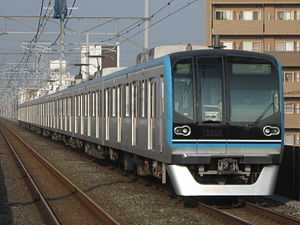Tokyo Metro 15000 series
| Tokyo Metro 15000 series | |
|---|---|
|
Set 15102 approaching Minami-Gyōtoku Station, October 2010 | |
| In service | May 2010–Present |
| Manufacturer | Hitachi |
| Family name | Hitachi A-train |
| Constructed | 2010–2011 |
| Number built | 130 vehicles (13 sets) |
| Number in service | 130 vehicles (13 sets) |
| Formation | 10 cars per trainset |
| Operator | Tokyo Metro |
| Line(s) served | Tokyo Metro Tōzai Line |
| Specifications | |
| Car body construction | Aluminium alloy |
| Car length |
20,520 mm (67 ft 4 in) (end cars) 20,000 mm (65 ft 7 in) (intermediate cars) |
| Width | 2,850 mm (9 ft 4 in) |
| Doors | 4 pairs per side |
| Maximum speed | 100 km/h (60 mph) |
| Acceleration | 3.3 km/h/s |
| Deceleration | 3.5 km/h/s (service), 5.0 km/h/s (emergency) |
| Electric system(s) | 1,500 V DC |
| Current collection method | overhead catenary |
| Bogies | FS778 |
| Safety system(s) | CS-ATC, ATS-P |
| Track gauge | 1,067 mm (3 ft 6 in) |
The Tokyo Metro 15000 series (東京地下鉄15000系 Tōkyō Chikatetsu 15000-kei) is an electric multiple unit (EMU) train type operated by Tokyo Metro on the Tokyo Metro Tōzai Line in Tokyo, Japan, since May 2010.[1]
Design
Based on the earlier Tōzai Line 05 series 13th batch and Yūrakuchō Line 10000 series trains, the new trains have 500 mm (20 in) wider doors (1,800 mm (71 in) as opposed to 1,300 mm (51 in)) to speed up boarding and alighting at stations during rush-hour periods.[1][2]
-

Exterior view, at Fukagawa Depot
Formation
As of 1 April 2012, the fleet consists of 13 ten-car sets, formed as shown below, with car 1 at the Nishi-Funabashi end.[3]
| Car No. | 1 | 2 | 3 | 4 | 5 | 6 | 7 | 8 | 9 | 10 |
|---|---|---|---|---|---|---|---|---|---|---|
| Designation | CT1 | M1' | M2 | T | Mc1 | Tc | T' | M1 | M2' | CT2 |
| Numbering | 15100 | 15200 | 15300 | 15400 | 15500 | 15600 | 15700 | 15800 | 15900 | 15000 |
| Capacity | 143 | 155 | 154 | 154 | 154 | 154 | 154 | 154 | 155 | 143 |
| Weight | 26.9 t | 33.6 t | 34.0 t | 24.3 t | 32.5 t | 24.3 t | 24.1 t | 33.8 t | 33.9 t | 26.9 t |
Cars 2 and 8 each have two single-arm pantographs. Car 5 has one single-arm pantograph.[4]
Interior
Passenger accommodation consists of longitudinal bench seating throughout, with 6-person seats between the doors, and 2-person seats at the car ends.[4] Passenger information is provided by pairs of 17-inch LCD information screens above each doorway.[4]
-

Interior view
-

6-person seat
-

Interior view showing 1,800 mm wide doorway
-

LCD passenger information display
History
The first set was delivered from Hitachi's Kudamatsu factory in February 2010.[5]
The first 15000 series sets entered revenue service on 7 May 2010.[6]
References
- ↑ 1.0 1.1 "Doors on new Tozai Line subway carriages to be extra wide to beat rush hour delays". The Mainichi Daily News (Japan: The Mainichi Newspapers Co. Ltd.). 6 April 2010. Retrieved 7 April 2010.
- ↑ Tokyo Metro news release: オールワイドドアの「15000系」新型車両を投入します (New 15000 series trains to be introduced with wide doors), 16 June 2009). Retrieved on 17 June 2009. (Japanese)
- ↑ 私鉄車両編成表 2012 [Private Railway Rolling Stock Formations - 2012]. Japan: JRR. July 2012. p. 75. ISBN 978-4-330-29911-2.
- ↑ 4.0 4.1 4.2 "東京地下鉄15000系" [Tokyo Metro 15000 series]. Japan Railfan Magazine (Japan: Koyusha Co., Ltd.) 50 (592): p.70–75. August 2010.
- ↑ "甲種鉄道車両輸送計画表" [New rolling stock delivery schedule]. Tetsudō Daiya Jōhō Magazine (Japan: Kōtsū Shimbun) 39 (311): p.125. March 2010.
- ↑ 東京メトロ15000系が営業運転を開始 [Tokyo Metro 15000 series enters revenue service]. Japan Railfan Magazine (in Japanese). Koyusha Co., Ltd. 7 May 2010. Retrieved 8 May 2010.
External links
| Wikimedia Commons has media related to Tokyo Metro 15000 series. |
- Tokyo Metro 15000 series information (Japanese)
| |||||||||||||||||

